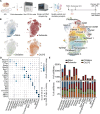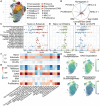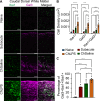Reawakening inflammation in the chronically injured spinal cord using lipopolysaccharide induces diverse microglial states
- PMID: 40022205
- PMCID: PMC11871772
- DOI: 10.1186/s12974-025-03379-6
Reawakening inflammation in the chronically injured spinal cord using lipopolysaccharide induces diverse microglial states
Abstract
Background: Rehabilitative training is an effective method to promote recovery following spinal cord injury (SCI), with lower training efficacy observed in the chronic stage. The increased training efficacy during the subacute period is associated with a shift towards a more adaptive or proreparative state induced by the SCI. A potential link is SCI-induced inflammation, which is elevated in the subacute period, and, as injection of lipopolysaccharide (LPS) alongside training improves recovery in chronic SCI, suggesting LPS could reopen a window of plasticity late after injury. Microglia may play a role in LPS-mediated plasticity as they react to LPS and are implicated in facilitating recovery following SCI. However, it is unknown how microglia change in response to LPS following SCI to promote neuroplasticity.
Main body: Here we used single-cell RNA sequencing to examine microglial responses in subacute and chronic SCI with and without an LPS injection. We show that subacute SCI is characterized by a disease-associated microglial (DAM) signature, while chronic SCI is highly heterogeneous, with both injury-induced and homeostatic states. DAM states exhibit predicted metabolic pathway activity and neuronal interactions that are associated with potential mediators of plasticity. With LPS injection, microglia shifted away from the homeostatic signature to a primed, translation-associated state and increased DAM in degenerated tracts caudal to the injury.
Conclusion: Microglial states following an inflammatory stimulus in chronic injury incompletely recapitulate the subacute injury environment, showing both overlapping and distinct microglial signatures across time and with LPS injection. Our results contribute to an understanding of how microglia and LPS-induced neuroinflammation contribute to plasticity following SCI.
Keywords: Chronic nervous system injury; Inflammation; Lipopolysaccharide; Microglia; Plasticity; Single-cell RNA sequencing; Spinal cord injury.
© 2025. The Author(s).
Conflict of interest statement
Declarations. Ethics approval and consent to participate: All animal studies were conducted in accordance with the Canadian Council on Animal Care Guidelines and Policies with approval from the Animal Care and Use Committee: Health Sciences for the University of Alberta under AUP #254. Consent for publication: Not applicable. Competing interests: The authors declare that they have no competing interests.
Figures




References
-
- Dietz V, Harkema SJ. Locomotor activity in spinal cord-injured persons. J Appl Physiol. 2004;96(5):1954–60. - PubMed
-
- Fouad K, Tetzlaff W. Rehabilitative training and plasticity following spinal cord injury. Exp Neurol. 2012;235(1):91–9. - PubMed
-
- Norrie BA, Nevett-Duchcherer JM, Gorassini MA. Reduced functional recovery by delaying motor training after spinal cord injury. J Neurophysiol. 2005;94(1):255–64. - PubMed
MeSH terms
Substances
LinkOut - more resources
Full Text Sources
Medical

